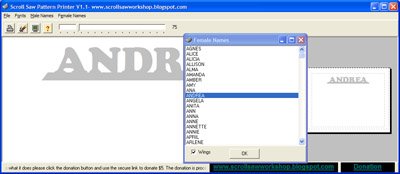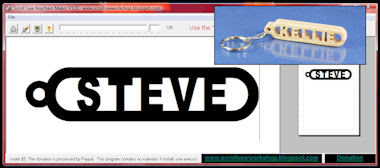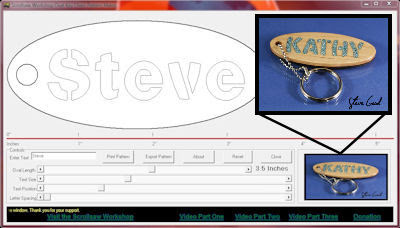I have lived in central Kentucky for nearly 40 years. All the surrounding counties are filled with horse farms. Many of the farms are stunningly beautiful. It's a real treat to drive through the countryside on a nice spring or summer day and see the new foals running through the fields.
This pattern uses a lot of veining for detail. The are a few places where I edited the pattern after I cut the project. Some of the veins made the piece too fragile. You will still need to be careful when you back the blade out of some of the veins.
Setting up a scroll saw workshop to mill scroll saw ready boards:
Table Saw
Thickness Planer
Band Saw
Jointer
I am going to keep this discussion very general and basic. I know that almost everything I mention in this write up has alternatives. There are different techniques that can be used to accomplish all of these tasks. Trust me when I say I have probably tried most of the alternatives. This discussion is not aimed at those of you who already have workshops and have been down this path already. This is for those who have just begun the journey.
If you have been in the scrolling hobby more than a couple days you have discovered that wood is expensive. On top of the expense it is also difficult to find boards in the thicknesses we often use on the scroll saw. The big box stores have very limited selections and even worse prices.
Many scrollers need to look online to find what they need. That's a great option and you can find what you need but the cost can go even higher because of shipping costs.
There comes a time when many scrollers want to be able to buy lumber in the rough and mill it to the thickness they need for a project. That is almost always the cheapest way to get thin boards.
If you are new to woodworking you may want to know what tools you need to mill your own boards. Which tools should you buy first? How much do you need to spend for those tools?
There are four primary tools used in a small woodworking shop to mill boards to size and thickness. Table Saw, Band saw, planer and jointer.
The heart of every woodworking shop is the table saw. It is primarily used for rip cut and cross cuts. Rip cuts run the length of the board and cross cuts are across the grain. In a limited way you can also resaw a board on a table saw. Resawing, is cutting the board to make it thinner. If the board is no wider than the height of the blade times two you can stand the board on edge against the rip fence and saw it in half.
It is nearly always my recommendation that you start your shop with a table saw. If your primary craft is scroll saw work then you do not need a very expensive table saw. A decent contractor saw will get the job done nicely.
The second toll I suggest for a scroll saw workshop is a thickness planer. Using a planer to make boards thinner is extremely wasteful. If you need a 1/4" thick board and you have a 3/4" thick board you are going to waste two thirds of the board. With the planer you can at least get a ready to use thin board. The next tool helps eliminate the waste of the thickness planer.
For a casual scroll saw workshop a lunchbox style planer like the DeWalt above will do fine.
The next purchase gets a bit tricky. To eliminate as much of the waste as possible from the planer you need a band saw. With the band saw you can take a one inch thick board and resaw it in half. Then each half can be passed through the planer to clean up the rough surface left by the band saw.
This is where the situations can start to get expensive. Slicing through several inches of wood is a tough task. If you want to resaw a board that is eight inches wide you will need a decent band saw and a good resaw blade. Most bench top band saws are just not up to the task. Because of the high cost of a good band saw most woodworkers put off adding this tool to their shop. Just consider that wood is expensive and if you are throwing much of it away as saw dust then the band saw can start to look cheaper by the inch.
The last tool in this discussion is the jointer. Most scroll saw workshops can get by without a jointer. The jointer is used to give a board one flat reference edge. That's important for building furniture and other large projects but many scroll saw projects can make do without it. One are that it can come in very handy for scroller is being able to clue up larger panels. The jointer is used to give a flat edge that is glueup ready. If you can afford a jointer then it's nice to have but definitely something you can live without. An entry level jointer will usually be fine for a dedicated scroll saw workshop.
There are plenty scrollers out there who do not own any of these tools. They are able to enjoy the hobby and make projects without any thought of spending hundreds of dollars to finish out a full workshop. There are thousands of project that can be made from 3/4" thick lumber purchased from Home Depot.
If you do want to upgrade your workshop then maybe a few of these suggestions will help.
Email Newsletter Readers: Remember that the Newsletter is just a copy of the daily blog post. To see the post in it's proper formatting click this link. If you ever misplace a pattern or any item you see here you can always find it on the blog. Everything stays on the blog forever.
your source for Pegas scroll saw blades and craft supplies.

Visit Heritage Wood Specialties
for your scroll saw ready boards.
Let me teach you to create a beautiful wooden portrait pattern. I will show you everything you need from start to finish. The video will show you the free software program you can download for Windows or Mac OS. I will show you how to install the program and configure it for best results.
Then I will show you the technique to take your photograph and make a pattern from it. When the pattern is complete we will go in the shop and cut it.
The DVD is $10 plus shipping. This is a data DVD that you will use on your computer to watch the video tutorial
Purchase the entire Scrollsaw Workshop pattern catalog for offline access.
This DVD has 2,300 patterns published from 2007 thru 2017.
The DVD is $20 plus shipping. Ships to 60 countries around the world.
The DVD is $20 plus shipping. Ships to 60 countries around the world.
If you use the DVD on a Windows PC there is a simple viewer program to browse through the patterns.
The DVD also works fine on a MAC. The viewer program is not MAC compatible but there is an included PDF with all the patterns shown as thumbnails for easy viewing.
My two "Wooden Vases on the Scroll Saw" books make it easy.
The books are $12 each and available for instant download after purchase. Click for Video
Demonstration.








































